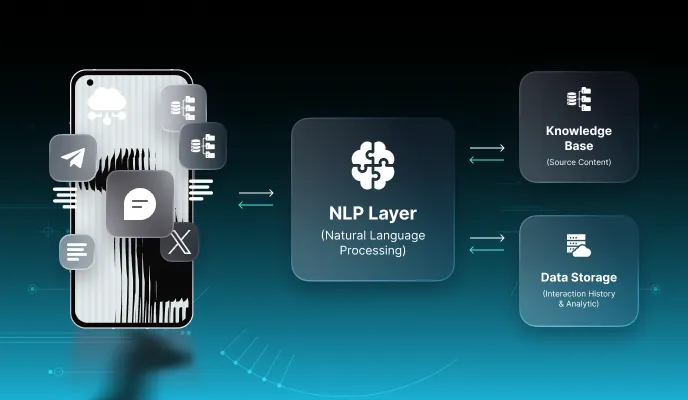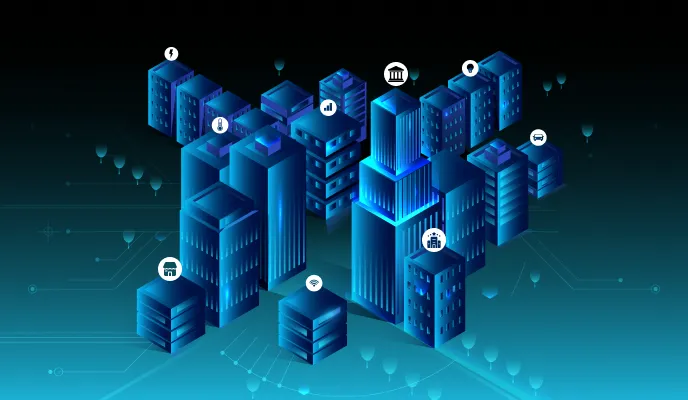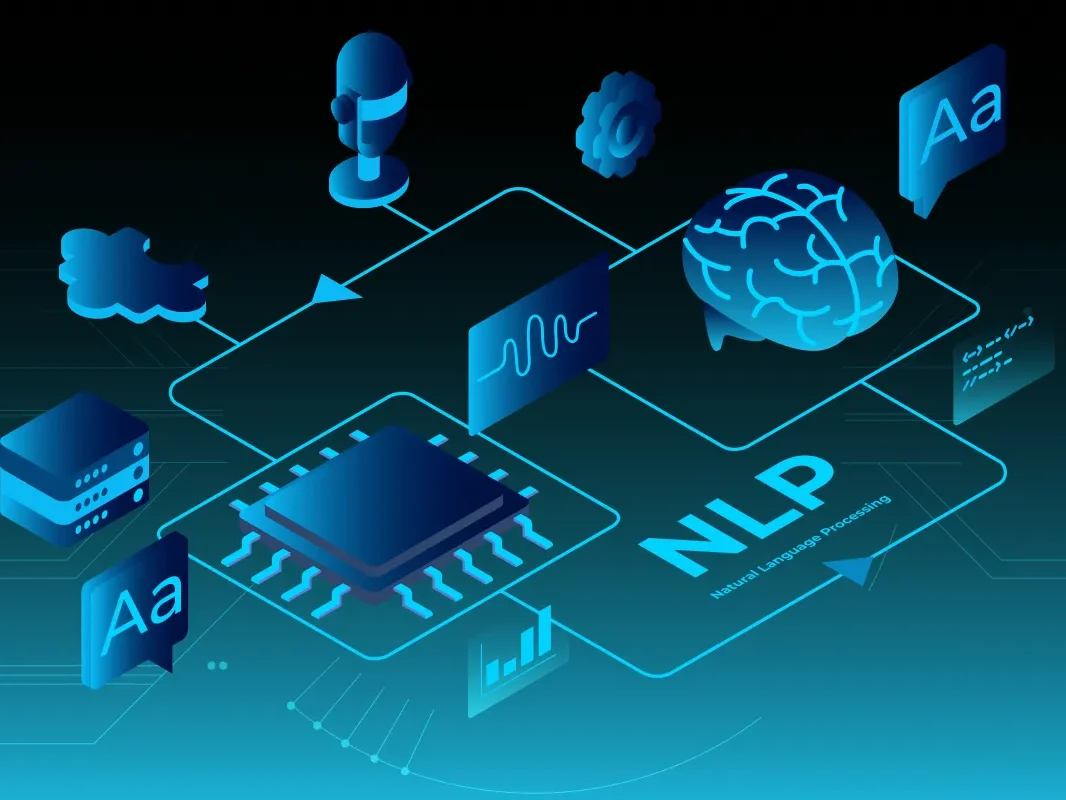Staying competitive and attaining business success depends on making smart decisions and adapting to evolving technology. Today, chatbots are one of the most remarkable technological advancements that business owners are ready to implement in the workflow. According to statistics, 57% of companies find that smart bots deliver a substantial return on investment (ROI) with minimal upfront costs.
In this blog, we’ll uncover what is NLP chatbot, and how it differs from rule-based and generative types. In addition, we will discuss the nuances of building such a chatbot and its key tasks.
Explaining What Is NLP Chatbot
NLP is an advanced technology that empowers machines to comprehend and engage using human language. Now, combine it with a “chatbot” – a digital smart assistant capable of interacting with users through conversation. The result? A powerhouse of innovation poised to reshape the way you do business.
Here’s what sets chatbot with NLP algorithms apart:
- Natural-Like Dialogues: They are fluent in the language of your customers. They can understand the nuances, context, and intent behind their queries. As a result, your business gets more natural and engaging interactions.
- Efficiency Redefined: Say goodbye to long hold times and frustrating support experiences. NLP chatbots are lightning-fast, providing instant assistance and freeing up your human team to focus on more complex tasks.
- 24/7 Availability: Whether it’s midnight or a holiday, your NLP assistant is always on duty, ensuring your customers receive timely responses and support whenever they need it.
- Scalable Support: As your business grows, so can your NLP-based bot. It can handle a multitude of customer inquiries simultaneously, ensuring a seamless customer experience even during peak times.
- Data-Driven Discoveries: AI NLP chatbots not only provide assistance but also collect valuable data on customer interactions, preferences, and challenges. This data can serve as a foundation for smart decisions and inspire enhancements in your business.
Thanks to routine automation, chatbot NLP machine learning cuts operational costs while delivering outstanding client care – a win-win for your business.
NLP in Artificial Intelligence
NLP is a vital component of AI that enables machines to understand and interact with human language. NLP empowers AI systems to comprehend text and speech, making it possible for them to engage in natural conversations, analyze sentiment, and perform tasks like language translation and text generation.
Additionally, NLP-driven AI systems enhance information retrieval, enabling search engines to understand user queries and provide relevant results. As NLP technology continues to advance, it continues to shape the way chatbot AI interacts with and understands human language, fostering innovation across numerous industries.
How NLP Chatbots Work

When a user sends a text message or speaks to the chatbot, the input is received and passed to the NLP component. To know what happens next, you should know how NLP works in chatbots. The NLP system tokenizes the input, breaking it down into individual words, phrases, or tokens. This step makes it easier to analyze and understand the text.
The next stage is called Intent Recognition. The chatbot natural language processing model identifies the user’s intent, which represents the purpose or goal behind the user’s message. Intent recognition is a crucial part of understanding what the user wants. Then, NLP also extracts specific entities or pieces of information from the user’s input. For example, in a flight booking chatbot, entities could include the departure date, destination, and number of passengers.
NLP systems use pre-trained models and machine learning algorithms to understand the meaning and context of the user’s message. This involves analyzing the structure of sentences, identifying parts of speech, and considering the context of the conversation.
The chatbot’s response generation component constructs a meaningful and contextually relevant reply. It may use predefined responses, retrieve information from databases, or generate responses dynamically based on the detected intent and entities. In multi-turn conversations, the chatbot’s NLP system manages the conversation flow. It keeps track of the context and maintains a coherent dialogue by remembering past interactions and responses.
How to build an NLP chatbot
Building an NLP chatbot involves various nuances due to the intricacies of natural language understanding and user interaction. Here are 5 basic steps of how to build a chatbot using NLP:
- Select a suitable development platform or framework, such as Dialogflow, Rasa, or IBM Watson, that supports the integration of NLP for chatbots.
- Gather a dataset of user queries and corresponding responses to train your assistant. Ensure the dataset is diverse and covers various scenarios.
- Integrate NLP libraries or APIs into your chosen platform to enable language understanding and processing.
- Define intents (user intentions or requests) and entities (specific information to extract) for your chatbot. Train your smart bot to recognize these intents and entities in user input.
- Thoroughly test your chatbot with sample user inputs to ensure it understands and responds accurately. Iterate and refine the chatbot’s training based on user interactions for continuous improvement.
It is important to ensure a positive user experience. It involves crafting responses that feel natural and empathetic.
Tasks in Which NLP Chatbots Are Masters
A chatbot using NLP plays a pivotal role in applications ranging from providing human-like interactions to sentiment analysis that gauges public opinion in text data.
- Customer Support: Providing instant assistance and resolving inquiries 24/7.
- Information Retrieval: Fetching real-time data like news, weather, and stock prices.
- Appointment Scheduling: Coordinating meetings and managing calendars efficiently.
- Language Translation: Facilitating multilingual communication.
- E-commerce Assistance: Recommending products and guiding purchases.
- Content Creation: Drafting articles, reports, and creative writing.
- Virtual Assistants: Setting reminders, sending notifications, and managing tasks.
- Personalization: Personalizing interactions based on user preferences and historical data. They offer tailored recommendations and responses.
- Sentiment Analysis: NLP chatbots are adept at analyzing user sentiment from text inputs. They are monitoring customer feedback, reviews, and social media sentiment.
- FAQ Handling: Precise answers and directing users to relevant resources.

NLP Chatbot vs. Generative vs. Rule-Based
The choice of chatbot type depends on the technological capabilities needed to address specific tasks and industries. Whether it’s enhancing customer experiences, automating processes, or engaging users in new ways, the right technology can make a significant impact. Let’s compare three basic types: chatbot using NLP, generative, and rule-based assistants.
| Aspect | NLP Chatbot | Rule-Based Chatbot | Generative Chatbot |
| Language Understanding | Comprehends natural language, context, and intent. | Lacks contextual understanding beyond predefined rules. | Understands language but can also generate human-like text. |
| Adaptability | Adapts to user input and learns over time. | Limited adaptability without rule changes. | Adapts to generate contextually relevant responses. |
| Complexity Handling | Complex, open-ended conversations. | Structured, simple tasks. | Creative content generation and complex interactions. |
| Training Data | Requires labeled data for supervised learning. | Uses fixed rules and decision trees. | Trained on diverse text data to mimic human language. |
| Use Cases | Ideal for customer support, chat applications. | Suitable for FAQs, guided processes. | Valuable for content creation, creative writing, and dynamic interactions. |
| Development Complexity | Moderate complexity due to NLP integration. | Relatively easy to set up and maintain. | Complex development involving deep learning models. |
As you can see, NLP chatbots offer adaptability and natural language understanding, making them perfect for dynamic interactions. A rule-based type is suitable for structured tasks like FAQs but lacks adaptability and complexity handling. Generative smart bots excel in creative content generation and complex interactions, thanks to their ability to generate text that mimics human language. The choice depends on your specific needs and tasks.
Final Thoughts
With NLP at the core, chatbots have transcended traditional human-computer interactions, seamlessly understanding and responding to human language, adjusting to user needs, and delivering personalized experiences.
The potential applications of NLP chatbots are boundless. From providing instant customer support that delights users to automating complex tasks and enhancing content creation, NLP-powered chatbots have become indispensable tools for businesses across diverse industries. They not only boost operational efficiency but also elevate customer satisfaction to new heights.
With the MetaDialog solution, you can get a ready-to-work AI-based platform to handle 87% of customer questions in just one hour. Our conversational AI solution is the gateway to a more efficient, engaging, and profitable future, from crafting intelligent customer interactions to automating tasks that drive growth. Contact us and get a demo to see all the benefits firsthand.
